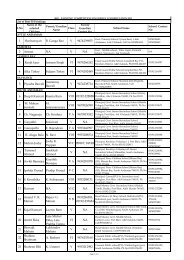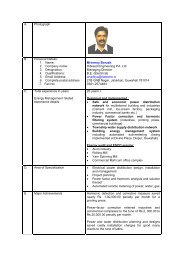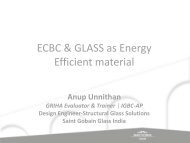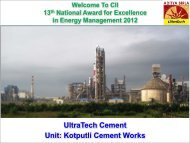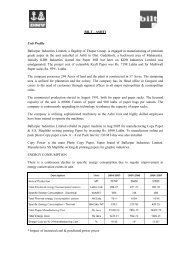sinicon pp
sinicon pp
sinicon pp
Create successful ePaper yourself
Turn your PDF publications into a flip-book with our unique Google optimized e-Paper software.
SINICON PP<br />
Presents<br />
PRATLIPERL<br />
Mix Ratio (by volume)<br />
Pratliperl : Cement<br />
Water (l) per 10kg<br />
(100l) bag of Pratliperl<br />
3:1<br />
1 Jumbo Bag<br />
Pratliperl<br />
(100l) + 1 Bag<br />
OPC 50Kg (33l)<br />
Low<br />
water*<br />
23<br />
TYPICAL PROPERTIES<br />
High<br />
water<br />
29<br />
4.5:1<br />
1.5 Jumbo Bag<br />
Pratliperl (150l) + 1<br />
Bag OPC 50Kg<br />
(33l)<br />
Low<br />
water*<br />
19.2<br />
High<br />
water<br />
24.2<br />
6:1<br />
2 Jumbo Bag<br />
Pratliperl (200l) + 1<br />
Bag OPC 50Kg<br />
(33l)<br />
Low<br />
water*<br />
19.2<br />
High<br />
water<br />
24.2<br />
10:1<br />
3.5 Jumbo Bag<br />
Pratliperl<br />
(350l) + 1 Bag<br />
OPC 50Kg (33l)<br />
Low<br />
water*<br />
19.2<br />
Slump (mm) 55 250 45 240 50 230 30+ 90+<br />
Flow (mm) 370 635 380 580 365 565 355 570<br />
Measured Air Content<br />
(%)<br />
High<br />
water<br />
24.2<br />
12 16 15 18 21 21 22 21<br />
Drying Shrinkage (%) 0.17 0.16 0.18 0.19 0.16 0.16 0.12 0.12<br />
Watering Expansion (%) 0.14 0.14 0.17 0.17 0.15 0.14 0.1 0.1<br />
7 day ISO flexuaral strength<br />
(Mpa)<br />
28 day ISO flexuaral<br />
strength (Mpa)<br />
7 day ISO compressive<br />
strength (Mpa)<br />
28 day ISO compressive<br />
strength (Mpa)<br />
7 day 100mm cube strength<br />
(Mpa)<br />
28 day 100mm cube<br />
strength (Mpa)<br />
3.7 1.9 3.4 2.0 1.5 1.1 - -<br />
4.9 2.7 4.2 2.5 1.8 1.3 - -<br />
14.2 5 12.6 5.2 3.9 2.3 - -<br />
19.8 7.5 16.9 6.3 4.4 2.9 - -<br />
16.9 7.3 15.6 6.9 4.7 3.1 1.2 0.8<br />
23 10 19 8.7 6 4.3 1.7 1.4<br />
Wet Density (Kg/m 3 ) 1400 1150 1250 1000 900 800 750 700<br />
Dry Density (Kg/m 3 ) 1100 900 800 650 550 450 360 350<br />
*Recommanded water content as indicated in bold however, for plastering and casting a<strong>pp</strong>lication use higher water content.<br />
The above are expected values using quality OPC, standard mixing times, proper curing practise and correct water ratio.<br />
NB! The water : cement ratio is very important. Numbers shown are per 100 Ltr. of Pratliperl.<br />
Mix Ratio (by volume)<br />
Pratiperl : Cement<br />
TYPICAL PROPERTIES<br />
External Plaster * †<br />
Internal Plaster * †<br />
SUITABILITY GUIDE OF PRATLIPERL<br />
Note: Before selecting a mix, check structural design and properties.<br />
3:1<br />
1 Bag Pratliperl<br />
(100l) + 1 Bag<br />
OPC (33l)<br />
4.5:1<br />
1.5 Bag Pratliperl<br />
(150l) + 1 Bag<br />
OPC 33l)<br />
6:1<br />
2 Bag Pratliperl<br />
(200l) + 1 Bag<br />
OPC (33l)<br />
10:1<br />
3.5 Bag Pratliperl<br />
(350l) + 1 Bag<br />
OPC (33l)<br />
√ √ x x<br />
√ √ √ x<br />
Built -up Floors √ √ x x<br />
Insulating roof decks √ √ √ x<br />
Fire Seals √ √ √ √<br />
Castables √ √ √ √<br />
Spray A<strong>pp</strong>lications * √ √ √ x<br />
Cast Thermal Insulation x x √ √<br />
† For improved fire resistance use 1 x 5kg bag "Pratliperl Fire Mix Additive"<br />
* For smooth substrate surfaces use "Pratley Plaster Grip Primer"<br />
"OPC" = Ordinary Portland Cement<br />
√ = suitable<br />
X = Not suitable
SINICON PP<br />
Presents<br />
PRATLIPERL<br />
How to Mix Pratliperl with Cement<br />
Introduction<br />
An<br />
Innovative<br />
Heat Proofing and<br />
Climate Control<br />
Plastering Material.<br />
Sand not required<br />
use Sinicon PP instead.<br />
All the principles of good concrete practice a<strong>pp</strong>ly to Pratliperl mixes.<br />
Equipment<br />
A mechanical means of mixing is suggested. A pan mixer is preferable as a drum mixer tends to make<br />
balls. If this equipment is not available, manual mixing with shovels is acceptable.<br />
As Pratliperl is a non-absorbent volcanic glass, water will not be absorbed into the material. The use of<br />
a sealed, leakproof container is therefore recommended to prevent leaching of the required amount of<br />
water.<br />
Mixing Instructions<br />
1. Mix Pratliperl and cement in a dry state first (a little water may be used to dampen slightly<br />
in order to su<strong>pp</strong>ress dust).<br />
2. Add the correct amount of water (refer to ‘Mix design and suitability guide’ – and note that<br />
the water is given in litres per 100 litres of Pratliperl!). The product may a<strong>pp</strong>ear very dry,<br />
especially if hand-mixed, but this is correct. It is important to monitor the amount of water<br />
added since small differences in water content have a large effect on overall consistency<br />
and slump.<br />
3. Mix, but do not overdo mixing time – about 30 seconds in a pan mixer is all that is required<br />
(longer mixing entrains too much air).<br />
Yield<br />
• A<strong>pp</strong>roximately 11 bags of Pratliperl will be required for each cubic metre of concrete/plaster<br />
to be mixed (cement and water will be added to this quantity of Pratliperl.) This a<strong>pp</strong>lies to<br />
all mixes mentioned in the mix design and suitability guide.<br />
Gunnite and Loose-fill<br />
Pratliperl concrete may also be gunnited. Because air velocities are used than for ordinary gunniting<br />
procedures, the rebound is lower. A further advantage is that the rebound can be re-used.<br />
PRATLIPERL can also be used as a loose-fill (without cement) to fill cavities for thermal insulation<br />
purposes.<br />
04How to Mix Pratliperl WIth Cement.doc – Rev. 0 Page 1 of 2
Some Very Important Tips :<br />
1 The water content is very important. Too much water will yield poor results and lead to<br />
shrinkage, weak concrete and cracking. Use only the water as per the ‘Mix design and<br />
suitability guide’.<br />
2 When plastering, use good conventional plastering techniques. Particular attention should<br />
be paid to the degree to which the plaster has set prior to levelling with straight edge. As<br />
with any plaster, it should be set sufficiently so that it is difficult to cause an indentation by<br />
a<strong>pp</strong>lying thumb pressure. If the straight edge is a<strong>pp</strong>lied prematurely, it will cause the<br />
plaster to debond from the wall and slump cracks will form. On smooth surfaces, use<br />
Pratley Plaster Grip Primer.<br />
3 As with any concrete or plaster, proper curing under damp conditions and out of direct<br />
sunlight is vital for success.<br />
4 The a<strong>pp</strong>lication will determine the exact water : cement ratio. For example– for casting<br />
and plastering a<strong>pp</strong>lications, the user may decide to use the high water content.<br />
(Refer to ‘Mix design and suitability guide’), whereas for screeds, a drier consistency and<br />
stronger product may be preferred, hence, a lower water content may be chosen.<br />
5 Once a<strong>pp</strong>lied, the surface must be kept moist for the first 14 days while curing. If the<br />
finished product is to be exposed to direct sunlight or fast cured, contact our office for<br />
advice on specialised additives.<br />
Example<br />
I wish to plaster my company’s server computer room internally to improve thermal insulation:<br />
1. Referring to the suitability guide, a 4.5:1 mix is selected since it can be plastered with<br />
ease and has sufficient strength.<br />
2. The wall area of the room is 80m2 and the plaster is to be 30mm thick. Assuming 11 jumbo<br />
bags Pratliperl per m3 : for 2.4m3 I will need 2.4 x 11 bags (each 100 litres) of Pratliperl,<br />
i.e. 26.4 (or 27) bags. For a 4.5:1 mix, this requires 17.6 (or 18) x 50kg bag cement<br />
(33litres each), since 1 bag of cement is required for every 1.5 bags Pratliperl.<br />
3. The higher water option should improve plasterability. The table indicates that 24.2 litres<br />
of water is required for every 100 litre bag of Pratliperl used.<br />
4. The PRATLIPERL and cement are first mixed in the dry state. Water is then added and<br />
mixed in further. This may be done on a non-absorbent floor using a spade.<br />
5. As the substrate is smooth, Pratley Plaster Grip Primer is painted on before plastering to<br />
ensure adhesion. The plaster is a<strong>pp</strong>lied in the conventional way, once the Pratley<br />
Plaster Grip Primer has dried until “just tacky” (a<strong>pp</strong>roximately 10 – 20 minutes).<br />
6. Once the plaster is set beyond the gel state, a straight edge is used gently to obtain a flat<br />
surface.<br />
7. It is then float finished; first wood float with a little water splashed on with a brush, and<br />
then by using a steel trowel.<br />
8. Finally, it is covered with a wet Hessian – sprayed regularly for the first 72 hours to ensure<br />
that it remains damp.<br />
04How to Mix Pratliperl WIth Cement.doc – Rev. 0 Page 2 of 2
SINICON PP<br />
Presents<br />
PRATLIPERL<br />
What is 'K' - value?<br />
ENERGY SAVING CALCULATION<br />
Pratliperl Plaster v/s Conventional Plaster<br />
'K' = the thermal conductivity of a material. Every material has its own unique thermal conductivity or 'K'<br />
Value. Pratliperl has a very low thermal conductivity. Pratliper ; K = 0.15 Watts/m. °C. This means that it will<br />
not allow heat to pass through it easily.<br />
Rate of Heat Exchange<br />
Q in Joules = K a (Temp 1 - Temp 2) x t<br />
L<br />
W = Q/t = K a (Temp 1 - Temp 2) x t<br />
L<br />
K = W x L = K = Watts x Meters<br />
a x (Temp 1 - Temp2) meters² (Temp 1 - Temp2)<br />
K = Watts<br />
meters °C<br />
ie. K = W/m. °C<br />
Q = Rate of heat exchange (Joules)<br />
K = Thermal Conductivity<br />
a = Area in square meters<br />
t = Time in seconds<br />
Q/t = Watts<br />
L = Thickness<br />
ø1, ø2 = Temp 1, Temp2 in °Kelvin<br />
ø1- ø2 = Temperature difference<br />
What is 'u' value<br />
'u' = heat loss per m² through a specific thickness of medium. The same material, but with different thickness<br />
have different 'u' vlues. u = K/m = w/m°C.<br />
Rate of Heat Loss through a specific thickness of material:<br />
u = k = W/m°C = Watts<br />
Thickness m m²°C<br />
K = Thermal Conductivity<br />
L = Thickness<br />
From the formula, we can see that the Rate that Heat is lost through a medium is dependent on the following:<br />
1) 'K' value (thermal conductivity) of a material.<br />
2) The thickness of the material.<br />
05Energy Saving Calculation.doc Page 1 of 2
ENERGY CONSUMPTION COMPARISON - CONVENTIONAL PLASTERING V/S<br />
PRATLIPERL<br />
WALL OF ROOM 1 WALL OF ROOM 2<br />
Wall With Conventional Plastering with Wall with Pratliperl Plastering and loose fill<br />
cavity in cavity<br />
ROOM 1 ENERGY CONSUMPTION<br />
The 'u' value of Wall of Room 1 can be calculated as follows:<br />
u = 1.5 = 5.36<br />
0.28<br />
ROOM 2 ENERGY CONSUMPTION<br />
The 'u' value of Wall of Room 2 can be calculated as follows:<br />
u = 0.15 = 0.536<br />
0.28<br />
ROOM 1 V/S ROOM 2 ENERGY CONSUMPTION DIFFERENCE<br />
The proportion of difference is hence : 0.536 = 1<br />
5.36 10<br />
CONCLUSION<br />
The total k value of wall =<br />
sum of 1 of each material.<br />
k<br />
Typically, a plastered 280mm<br />
- cavity wall has a k-value of<br />
1.5W/m °C<br />
The total k value of wall = sum<br />
of 1 of each material.<br />
k<br />
Typically, a Pratliperl plastered<br />
280mm - cavity wall with loose<br />
Pratliperl fill in the cavity has a kvalue<br />
of 0.15W/m °C<br />
A Pratliperl plastered wall with loose Pratliperl fill will lose only a tenth (0.1) of the heat (or in other words<br />
heat that would enter in to the room) that an ordinary 280mm plastered cavity wall would loose.<br />
Example, if the cost of electricity is (US$/Dhs/Rs) 1.00 per KW/Hour and that the room must remain at a<br />
constant temperature of 5 °C and the outside temperature is 25°C it would cost 10.00 or 10 times more per<br />
KW/hour to keep the inside temperature of Room 1(with conventional plastering) at 5°C compared to Room 2<br />
(Pratliperl Plastering).<br />
Thus the total cost saving in energy through Pratliperl Plaster solution is 90%.<br />
05Energy Saving Calculation.doc Page 2 of 2


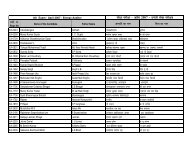
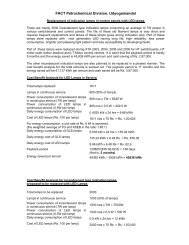
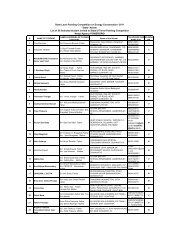
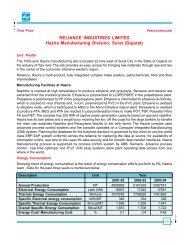

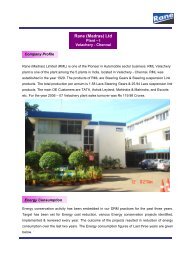
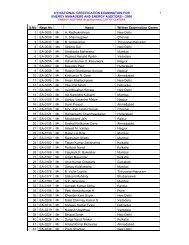
![Armstrong-Utility Soluitions [Compatibility Mode] - Energy Manager ...](https://img.yumpu.com/15315503/1/190x146/armstrong-utility-soluitions-compatibility-mode-energy-manager-.jpg?quality=85)
